This post provides a flashback of this year’s summer time in Seoul. I spent most of July and August in Seoul. It has been more than a month since my departure, but memories still linger in my head. On the contrary to my experience in Europe where summer is the holiday season or Shanghai where the heat slows life down to a standstill, Seoul was full of activity even during summer – openings, screenings, lots of fun things to do. I kept facing the usual Korean language barrier and obnoxious website designs, but still, I managed. It needs time to find one’s way around Seoul as a foreigner, but the art is there… somewhere. I ordered the sections alphabetically according to the name of the gallery/museum. Table of contents:
Artclub1563, Artsonje Center, Corner Art Space, Dotolim, Ilmin Museum of Art, Insa Art Space, Mullae: Jungdabang + Flatfic + Seoul Art Space_Mullae, Pool Art Space, Seoul Museum of Art (Main Building), Seoul Olympic Art Museum, SongEun Art Space, Songwon Art Center, Sungkok Museum
Artclub1563: Ade Darmawan “Home_Theater” http://artclub1563.com
Artclub1563 is located close to Seocho or Seoul Nat’l Uni of Education subway stops, away from the usual art Seoul art districts. As a space it looks clean and nice – one medium-sized exhibition hall. Ade Darmawan is – based on the handout – a prominent Indonesian artist. The space was occupied by one large installation. It seemed that Darmawan went to the flea market and bough off number of miscellaneous objects – worthless, but symbolizing a certain middle-class status: Plastic trophy’s from sport competitions, table lamps, old books… I forgot what exactly. These objects were then installed in a museum-like fashion on shelves and in display cases. What it actually meant, not sure… I forgot the handout text as soon as I walked out of the room… Artsonje Center: Heeseung Chung “Inadequate Metaphors” + “Our Hesitant Dialogues” + “Real DMZ Project 2013” http://www.artsonje.org
Artsonje Center: Heeseung Chung “Inadequate Metaphors” + “Our Hesitant Dialogues” + “Real DMZ Project 2013” http://www.artsonje.org
Artsonje is THE art space in Seoul, and one can never go wrong stopping by to see what is going on here. During the summer, I saw three shows taking place there: First, there was Heeseung Chung’s “Inadequate Metaphors”, taking place simultaneously with the “Our Hesitant Dialogues” group show. Then in August “Real DMZ Project 2013” opened, spreading around the whole building and even beyond it all the way into the demilitarized zone (DMZ) between North and South Korea.
“Inadequate Metaphors” featured photographs and minimalist installations by Heeseung Chung. Everything was minutely executed – extra large, super clear photos of every day ‘still lives’, portraits without expression. The artwork felt very detached. It was a very formal approach to photography, and the presumed ‘neutrality’ – as little ‘expression’ as possible – was probably the intention of the artist. The exhibition could be seen as a quest for ‘objectivity’ in photography, leaving the question open if it ever can be achieved.
“Our Hesitant Dialogues” was a quadruple of collaborative projects – four artists showed four very different works created in collaboration with their own parents. Soyoung Lee questioned their parents on ‘difficult questions’ to ask, re-enacted the dialogues and presented the results in a mixed media installation. Minja Gu created the “Gu & Yang Art Foundation” run by her parents with the goal of supporting her artistic career – an institutionalization of the existing support she was receiving from them. Hyungji Park worked on a collaborative painting project with her mother who is a hobby painter: She provided painting instructions to her mother and so did her mother to her. Sunghui Lee curated a calligraphy exhibition of works created by her father. This show was great in addressing a number of relationship questions every one can relate to generally. At the same time each work was very personal as artists talked about their own families. I am guessing Minja Gu was probably the mastermind behind this exhibition proposal as it would align quite well with her artistic practice.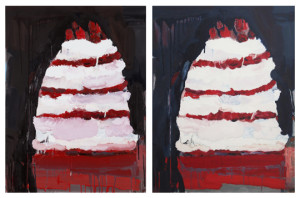 The “Real DMZ Project” was an exhibition addressing the Korean reality of the demilitarized zone and what is beyond it. There was quite a lot of photographs, some video documentaries balancing on the edge between fiction and reality. The show did not just take place at Artsonje, but also in the actual DMZ zone around Chaerwon – I unfortunately missed that part of the exhibition. The Artsonje part of the exhibition which I did see made an ambiguous impression on me. It showed how difficult it is to talk about a situation that is still ongoing, a situation one is part of, a situation within which the exhibition itself takes place. There is no stepping back or changing of viewpoint possible. Thus, the majority of works followed the ‘commonly agreed upon’ ideological line, focusing on the totalitarian rule and inaccessibility of North Korea. Within South Korea, it would be probably even a criminal offense to express any other view than that. The only way to escape from this situation is to move into the area of fiction, as Park Chan-Kyong did his installation “Power Passage” (2004). The most memorable work for me was the semi-fictional documentary “Madame & the Little Boy” (2009) by Magnus Bärtås about a South Korean actor/director couple who were kidnapped by North Korea and forced to work on a movie production. Maybe it was Bärtås’ distance from the actual situation that made his work interesting – he was able to talk about an event as (hi)story while it remained an ongoing reality for others. Overall it was not an easy task and topic to make an exhibition about, yet the result was definitely worth to see.
The “Real DMZ Project” was an exhibition addressing the Korean reality of the demilitarized zone and what is beyond it. There was quite a lot of photographs, some video documentaries balancing on the edge between fiction and reality. The show did not just take place at Artsonje, but also in the actual DMZ zone around Chaerwon – I unfortunately missed that part of the exhibition. The Artsonje part of the exhibition which I did see made an ambiguous impression on me. It showed how difficult it is to talk about a situation that is still ongoing, a situation one is part of, a situation within which the exhibition itself takes place. There is no stepping back or changing of viewpoint possible. Thus, the majority of works followed the ‘commonly agreed upon’ ideological line, focusing on the totalitarian rule and inaccessibility of North Korea. Within South Korea, it would be probably even a criminal offense to express any other view than that. The only way to escape from this situation is to move into the area of fiction, as Park Chan-Kyong did his installation “Power Passage” (2004). The most memorable work for me was the semi-fictional documentary “Madame & the Little Boy” (2009) by Magnus Bärtås about a South Korean actor/director couple who were kidnapped by North Korea and forced to work on a movie production. Maybe it was Bärtås’ distance from the actual situation that made his work interesting – he was able to talk about an event as (hi)story while it remained an ongoing reality for others. Overall it was not an easy task and topic to make an exhibition about, yet the result was definitely worth to see.
 Corner Art Space: Kang YoungMean “The State, Revolution & You” +
Corner Art Space: Kang YoungMean “The State, Revolution & You” +
Ha Cha Youn: “Jjockbang Project” http://www.cornerartspace.org
Corner Art Space is close to Apgujeong Station right across from the Hyundai department store. It had quite a packed program with exhibitions changing every couple of weeks. I wondered whether this speed was a reaction to the commercial/fashion environment of its surrounding. I made it to two of their shows:
Kang YoungMean’s “The State, Revolution & You” was, in a nutshell, a political-pop-art exhibition. Kang seems to work by picking up hot themes from the news and transform them by adding another layer of absurdity. Prominently on display: An Andy-Warhol-like silkscreen of the newly elected South Korean president Park Geun-hye wearing a Che-Guevara hat and hairdo. On the back side of the canvas: An silk-screened image of her father, Park Chung-hee, former president of South Korea. On the back wall of the gallery: Reproductions of Park Chung-hee’s calligraphy in red, spattered with more random red spots on top. I was not sure what to think or say about it, even though I was able to identify the source elements of the artwork… Definitely some material to talk about for those who have something to say about it. Ha Cha Youn’s “Jjockbang Project” was different in its execution, but there was a link in the political charge the work carried. Ha documented a number of very simple performances in Mullae, a poor/industrial area of Seoul (see another section of this article). Most of these performances consisted of simply walking around streets, sometimes assembling or relocating materials found on the streets. The central topic was ‘Jjockbang’ housing – miniature rooms without amenities, just big enough to fit a bed – some of the person’s belongings have to be stored outside. The artwork worked mainly through drawing attention to the social and economic questions of a persons subsistence. Again, something to think about, for those who have something to think about it.
Ha Cha Youn’s “Jjockbang Project” was different in its execution, but there was a link in the political charge the work carried. Ha documented a number of very simple performances in Mullae, a poor/industrial area of Seoul (see another section of this article). Most of these performances consisted of simply walking around streets, sometimes assembling or relocating materials found on the streets. The central topic was ‘Jjockbang’ housing – miniature rooms without amenities, just big enough to fit a bed – some of the person’s belongings have to be stored outside. The artwork worked mainly through drawing attention to the social and economic questions of a persons subsistence. Again, something to think about, for those who have something to think about it. Dotolim: Itoken + Jin Sangtae http://www.dotolim.com
Dotolim: Itoken + Jin Sangtae http://www.dotolim.com
Dotolim is a miniature space housed in a regular office building, in a regular office space. During daytime it probably serves as an office too. On selected nights, dotolim is transformed into a concert space focusing on experimental electronic music. The small size of the space gives it a very homey feeling, like entering someone’s living room. I ventured to dotolim for a performance of Itoken and Jin Sangtae (who is also the owner/manager of dotolim). Itoken sounded IDM like; one could watch how he life-sampled pieces of sound generated by different self-made electronics and shaped them into a sound composition. The compositions were rhythmic which made them more ‘listenable’, but it still did sound innovative and original. Jin Sangtae’s performances are more on the improvisation side; he did not use electronics, but a trumpet-like instrument in combination with different metal ware used to dampen the sound coming out of the instrument. The focus on individual sounds was balanced with an equal focus on silence in between these sounds. While the silence/sound balance was more prominent in Jin Sangtae’s performance, it could be said about Itoken’s performance too in the sense that there was a period of ‘listening’ when the performer was life sampling the sounds which was followed by a period of ‘playing’ when the performer played back and layered the sampled sounds. In Jin’s performance, balancing was that between periods of ‘preparation’ when he arranged his instrument setup and periods of ‘action’ when he blew into the horn and the resulting modulated sound came out – in relation to the instrument the sound became almost sculptural.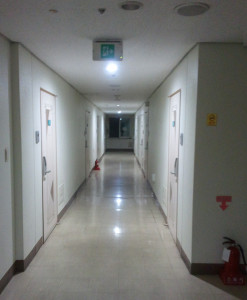
Ilmin Museum of Art: “Brilliant Collaborators” http://www.ilmin.org
Located right in the centre of the city on Gwanghwamun square near to the beginning of the Cheonggyecheon stream park, this museum has been founded by a newspaper publishing company. The exhibition on display focused on modes of collaboration between artists: Sound and image, space and movement. Different areas of the museum displayed a selection of works that one artist carried out in collaboration with others. Jung Young Doo – choreographer, Jang Young Gyu – musician, Choi Choon – architect, David Michael DiGregorio (dogr) – musician, Kwon Byungjun – musician/sound artist. As there were many audiovisual works – either as a documentation of a performance or as an actual video/movie – the exhibition demanded a lot of time to take in. If the visitor took the time, the experience was quite rewarding. One could dive in to individual works shown on projections or monitors, most of them equipped with seating options (floor carpet or sofa – highly appreciated). As each of the work was a collaboration, the works varied quite a lot in style and form. One had to take them in one by one rather than taking in the exhibition as a whole. I was most touched by the work of Lim Minouk, a video in cooperation with Jang Young Gyu titled “S.O.S. Adaptive Dissensus (2009) – a semi-fictional documentary of a boat journey on Seoul’s Han River, investigating locations along the river infused with stories (acted out on the river banks while the ship passed by) with a social-political undertone. (Photo is of Kwon Byungjun’s installation)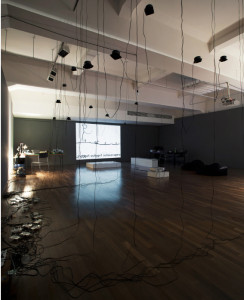 Insa Art Space: “Taansan Video Relay” http://facebook.com/iasarko http://www.taansan.net
Insa Art Space: “Taansan Video Relay” http://facebook.com/iasarko http://www.taansan.net
Taansan was a series of six video screenings taking place during the summer nights at Insa Art Space, right next to the wall of Changdeokgung palace. Depending on the weather forecast, the screenings took place either inside of the space itself or on a parking lot outdoors, in front of the art space.
The first night I went there was an opening concert, after which the screening of Kim Woong-huyn’s video’s started. The screening took place inside of the center and it was packed. Kim’s videos were commenting on the overlap between virtual and real world: Computer game characters (played by actors) found themselves in real-life situations while keeping to their virtual world habits. However now they had to fight with real-world facts like gravity or deep mud: They seemed a bit helpless. The makeshift ‘laser gun’ props, weird colorful clothing and shooting locations made the computer game characters look like homeless persons collecting trash. In a fact that’s what they were in the ‘real world’ – far away from their digital dreamscapes.
 I enjoyed the first Taansan screening and decided to come back again another day. That day a longer piece by Uhm Qui was being screened. It was a nice summer night and the screening took place in the open air across from the art space. Unfortunately this time the video was quite long, almost like a feature movie. That would not be an issue in itself, but unfortunately it came with narratives and voiceovers, but without English subtitles – just pure Korean. So while I sat through it and I understood that it was a re-interpretation of the Mandragora/Mandrake myth, I did not really take much away from it.
I enjoyed the first Taansan screening and decided to come back again another day. That day a longer piece by Uhm Qui was being screened. It was a nice summer night and the screening took place in the open air across from the art space. Unfortunately this time the video was quite long, almost like a feature movie. That would not be an issue in itself, but unfortunately it came with narratives and voiceovers, but without English subtitles – just pure Korean. So while I sat through it and I understood that it was a re-interpretation of the Mandragora/Mandrake myth, I did not really take much away from it.
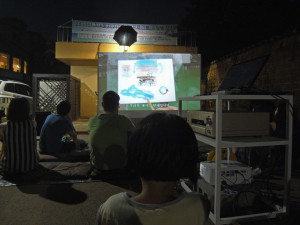 After the second screening I felt a bit discouraged and did not come back again, even though I noticed that one or two screenings did mention there were English subtitles. Still, Taansan was a fun event.
After the second screening I felt a bit discouraged and did not come back again, even though I noticed that one or two screenings did mention there were English subtitles. Still, Taansan was a fun event.
Mullae: Jungdabang + Flatfic + Seoul Art Space_Mullae
http://www.jungdabang.com
http://www.flatfic.com
http://eng.seoulartspace.or.kr/space_mullae/introduce.asp
Mullae is an industrial area of Seoul, mainly consisting of small to medium sized metal workshops. As a ‘post-industrial’ area, some creative projects are getting a foothold here, partially because of the government funded Mullae Art Space. I came here one day to meet a friend, walk around the area and to check out Mullae Art Space. The area was fascinating through the many workshops at street level where one could see workers working on all imaginable products made from metal. Some artists probably make use of these production opportunities as well. I stumbled upon an art space in a cellar called Jungdabang, this seemed to be an artist run space, with miscellaneous workshops etc. taking place, but unfortunately the door was locked.
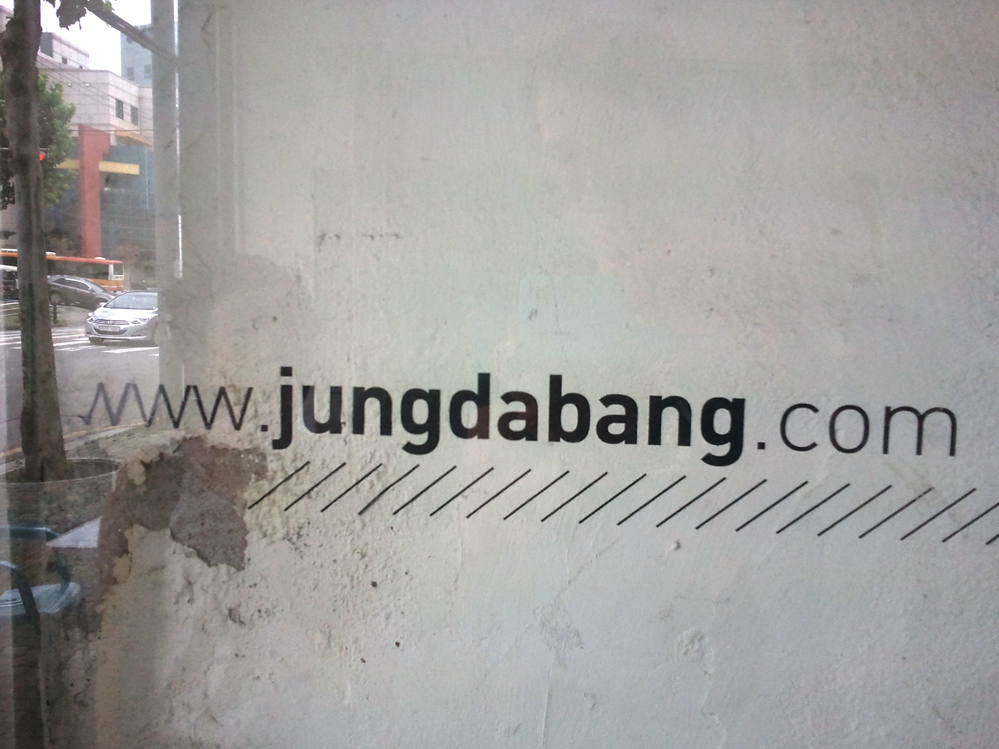 I stopped by at a ‘creative’ coffee shop (Flatfic) located on the second floor above a metal workshop. Stickers in the hallway indicted names of well known artists, but the dust on the door indicated that this was a remnant of the past, and the door was locked, again.
I stopped by at a ‘creative’ coffee shop (Flatfic) located on the second floor above a metal workshop. Stickers in the hallway indicted names of well known artists, but the dust on the door indicated that this was a remnant of the past, and the door was locked, again.
 Finally I ventured inside of the actual Mullae Art Space. My feeling there was that of a creative industry zone slash children’s community centre. Supposedly a festival was going on during my visit, but I could not see much, there seemed to be a focus on dance performances. On the ground floor there was a mediocre ‘art exhibition’ with 3-4 artworks on display. On top of that, this was the first time in Korea that the guard asked me to not take pictures of the exhibit. Did they want to keep it a secret?
Finally I ventured inside of the actual Mullae Art Space. My feeling there was that of a creative industry zone slash children’s community centre. Supposedly a festival was going on during my visit, but I could not see much, there seemed to be a focus on dance performances. On the ground floor there was a mediocre ‘art exhibition’ with 3-4 artworks on display. On top of that, this was the first time in Korea that the guard asked me to not take pictures of the exhibit. Did they want to keep it a secret?
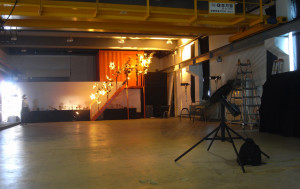 Well.. to conclude the ‘art’ stayed hidden during my visit to Mullae. The area has a very distinctive atmosphere which makes it worth a visit. To get hold of some interesting art, it would probably need a more thorough investigation and better timing than one afternoon stroll.
Well.. to conclude the ‘art’ stayed hidden during my visit to Mullae. The area has a very distinctive atmosphere which makes it worth a visit. To get hold of some interesting art, it would probably need a more thorough investigation and better timing than one afternoon stroll.
Pool Art Space: Kim Kyoung-Ho “Magic Bullet Broadcasting Network” + Ha Cha Youn “Localization http://www.altpool.org/
Pool Art Space is outside of the usual gallery areas in Seoul, in the North of the city, close to a mountain range (Bukhan Mountain?), which means it takes time and navigation skills to get there. Once there, I was pleasantly surprised at the neat space which featured two small exhibitions. Kim Kyoung-Ho’s “Magic Bullet Broadcasting Network” investigated how South Korea is presented in Iranian newscasts: By comparing news reels uploaded to Iran and their slightly censored broadcasted versions; by interviewing the news presenter; by showing the news presenter in a set of photographs; and by showing a research library of books and archived news broadcasts. A meaningful work which invited the viewer to spend time with it, watch, listen or flick through the displayed books. Ha Cha Youn’s presence in the space was limited to one small video projection showing an excavator moving around travel baggage – I understood it as a reference to Ha’s themes like migration and displacement, but it was a bit too cryptic in its actual meaning. I understood the context a bit more when I saw her show at the Corner Art Space (see other entry). I did not regret my long journey to Pool, seems to be a place to watch.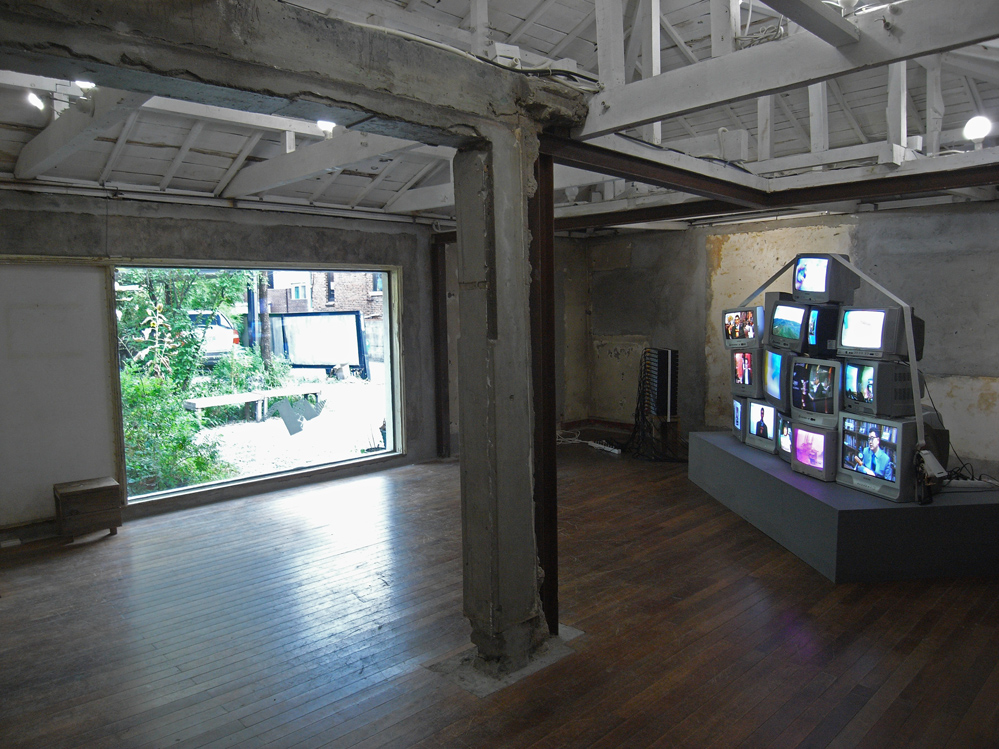 Seoul Museum of Art (Main Building): Kim Ku-lim: “Like You Know It All” + “Video Fever” http://sema.seoul.go.kr
Seoul Museum of Art (Main Building): Kim Ku-lim: “Like You Know It All” + “Video Fever” http://sema.seoul.go.kr
The Seoul Museum of Art (SeMA) usually specializes in blockbuster exhibitions, e.g. the Van Gogh exhibition that was on during my visit, overcrowded with art-hungry Korean families. But besides those shows, SeMA puts on other more ‘contemporary’ events as well. The Kim Ku-lim retrospective was a great chance to get acquainted with a major representative of Korean conceptual/performance art. Given the immateriality of most works, the show featured mainly photo documentation and reconstructions of sculptures, with occasional original artworks. It provided a nice variety of media, and a very strong and easy to understand narrative. This textbook-like presentation (including very direct labels explaining ‘what the artist wanted to express’) were a bit over the top for me, but at the same time it was quite useful. Obviously, as a city-run institution, SeMA has to make sure that it explains its display well to the general. In some way, this approach gave me a very friendly and nice impression of the museum. A similar strategy was used in the one-room “Video Fever” exhibition that presented video art from the SeMA collection. Four works – Isaac Julien, Pipilotti Rist, Joan Jonas and Gary Hill – were on display sequentially, accompanied by four small monitors where artists themselves were explaining their practice. There were seats to sit on, and the selected videos had a reasonable length of a few minutes. Once again, a simple yet very inviting way of presenting video art and making it accessible to a broader public.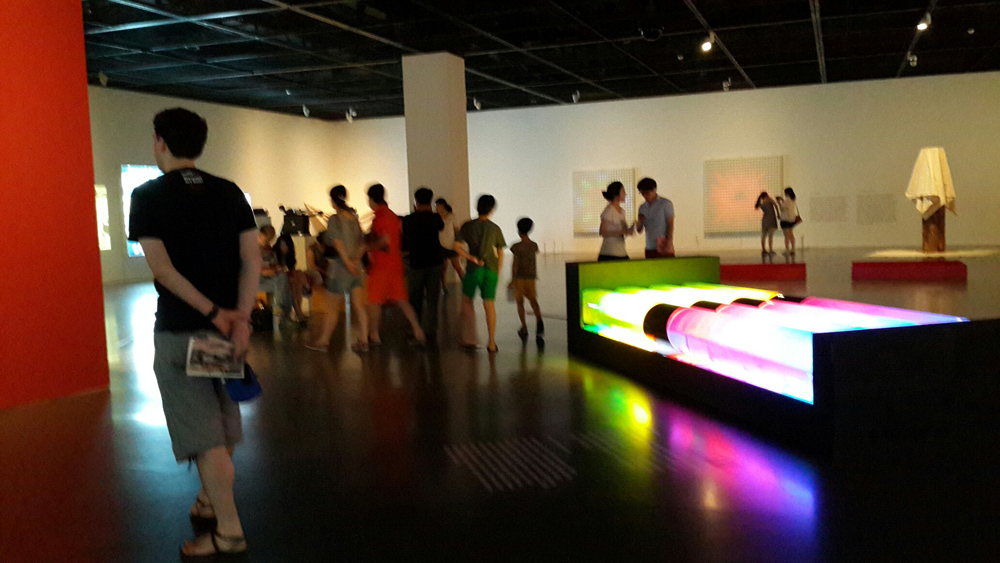 Seoul Olympic Art Museum: “Power, where does the beauty Lie? http://www.somamuseum.org/
Seoul Olympic Art Museum: “Power, where does the beauty Lie? http://www.somamuseum.org/
The first impression of SOMA was its location within the Olympic Park, surrounded by outdoor sculptures. The architecture of the museum building itself was also very intriguing. The group exhibition on display inside was a bit tame for my taste. The selection of artworks related to the topic in the title was a bit too eclectic for me, from classical-looking pre-modernist looking bronze sculptures (Wu Weishan, Yin Xiaofeng) to shopping-mall-worthy interactive video screens (team*Lab). Likewise, an omnipresent Namjune Paik TV monitor installation could not be missing. The curators were taking a safe bet by selecting recognizable and easy-to-explain works: A family friendly exhibition. This result can be probably related to the SOMA conception itself, where a general public outreach is probably a big priority. The new, and therefore most interesting work for me were sculptural objects from semi-transparent plastic sheets by Koh Myungkeun (“Building Studies”, 2013). I saw a connection to my own artworks investigating the relationship between the seen, the memory and it’s representation in an urban environment. SongEun Art Space: Sekyung Lee “Recollection” + Jake and Dinos Chapman “The Sleep of Reason” + art:21 screening http://www.songeunartspace.org
SongEun Art Space: Sekyung Lee “Recollection” + Jake and Dinos Chapman “The Sleep of Reason” + art:21 screening http://www.songeunartspace.org
SongEun is a shiny high-end art space in the Cheongdam area of Seoul. The space is quite big, with three exhibition floors (of a regular-sized house, not a museum), a large underground lecture hall and a fancy restaurant. I came here twice. First time it was for a screening of the art:21 art in the 21st century (#3) documentary screening – I can recommend this to anyone interested to know more about different approached to artistic creation today. At the same time, I peeked into the Sekyung Lee exhibition taking place upstairs. Now, what Lee is doing is something quite eerie for me. She ‘draws’ on porcelain using human hair. She knits carpets from human hair. Everything hair. And porcelain. The result looks equally or even more precise than the minute brushstrokes on finely painted porcelain. Interesting, yet the artworks became soon repetitive for me. Once the effect became familiar, I focused back on the content again, and there I could not find anything out of the ordinary. The second time I came back for a Jake and Dinos Chapman show. While not entirely my style, the show was convincing in its setup and variety of works – from life-size mannequins to Chapman-style gruesome mass scenes minutely assembled from plastic model kits, silver-cast sculptures and fake(?) ethnographic-like museum of McDonalds-themed African ‘aboriginal’ art. The show did a good job in representing the eclectic and ‘shocking’ work of the Chapman brothers.
The second time I came back for a Jake and Dinos Chapman show. While not entirely my style, the show was convincing in its setup and variety of works – from life-size mannequins to Chapman-style gruesome mass scenes minutely assembled from plastic model kits, silver-cast sculptures and fake(?) ethnographic-like museum of McDonalds-themed African ‘aboriginal’ art. The show did a good job in representing the eclectic and ‘shocking’ work of the Chapman brothers.
 Songwon Art Center: “Monsieur Hulot’s Holiday” link unknown
Songwon Art Center: “Monsieur Hulot’s Holiday” link unknown
Songwon Art Center is housed in the basement of a nicely designed modern building. While the design is nice, the gallery and exhibition program seems to be under construction: All information I was able to find was about the building itself rather than about the gallery and its program. For this exhibition, the programming has actually been “outsourced” to Corner Art Space mentioned in another section of this post.
The group exhibition seemed rather tame and it did not leave a too strong impression in me. I will just mention Min Byung Hun’s Snowland Series – light low contrast photograph of mountains covered with snow – which reminded me very clearly of the winter in Korea. Other artists participating were Nak Beom Kho, Kim Yu Jung, Lee Je, Min Byung Hun, Fahrettin Orenli and Yangachi.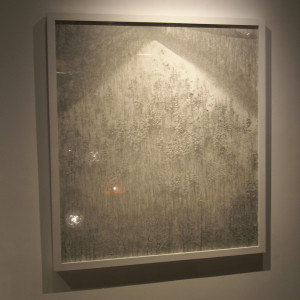 Sungkok Museum: Chan Sook Choi “The Nine Billion Names of God” http://www.sungkokmuseum.com
Sungkok Museum: Chan Sook Choi “The Nine Billion Names of God” http://www.sungkokmuseum.com
Sungkok Museum is not too far for the Gyeongbokgung palace – the other side of the palace than the majority of art galleries around there. It seems to be established by a company (or the company’s founder). It consists of two separate buildings and a sculpture park with a coffee shop. Both of the buildings have an exhibition space. During my visit, there was a solo show of Chan Sook Choi. Her themes seem to be quite heavy – religion, human fate. I always appreciate when someone tries to take on these big topics, I think it requires a certain amount of bravery. There is also always the danger of being overly pathetic and loose the audience. But this was not the case here. Actually this exhibition was a test on how efficient the artwork is in itself, without any explanation or text: Both the information handouts as well as the text contained in the artwork itself was Korean and therefore inaccessible to me.
There was a room with multiple projections – I think it was a man and a women walking around ruins of a building – and I was not so keen on that as it fell in the category of ‘boring’ video art for me. Then there was a project of photographs of old ladies from Germany, including an installation where the prints were being dissolved in liquid. This was a part of the exhibition which I was quite keen on. Stories of people were present, but not just documented, also augmented by the way they were installed. The main exhibition hall featured an spatial installation, a kind of semi-transparent maze and custom built stage. Within this architecture artworks were placed and occasionally a performance took place (which I did not see). Overall, even though I did not understand a single word, I had a feeling that this was a good exhibition and a nice place that I have discovered, thanks to my friend.
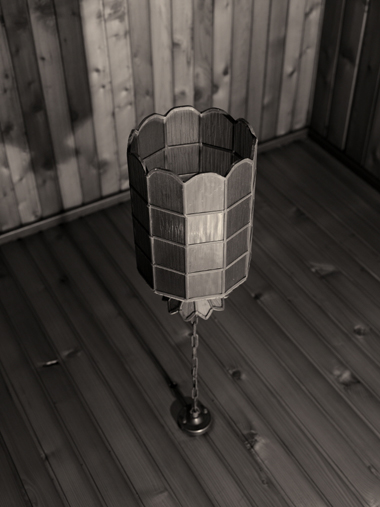
3 comments for “Seoul.Art.Summer.2013”